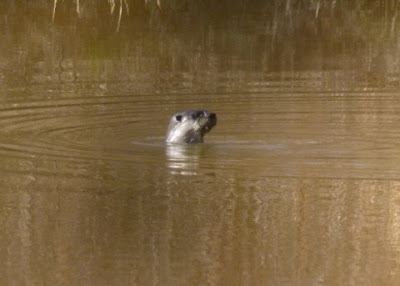The weather doesn't quite seem to know what to do at the moment as it bounces between unseasonably mild and flurries of snow, then back again. Overall, though it is certainly a vast improvement on the last two winters when we have had over two feet of snow at Cape May - not much for those of you up north or out west I know, but far from expected here at the cape. Certainly mildness prevails, as shown by reports of a Monarch at Cape May Point State Park on January 1st and another (or the same?) feeding at pansies in a wildlife garden at Cape May Point on the 8th. Orange Sulphurs continue to be seen too, though no dragonflies have been reported to me so far this year.
Winter is all about raptors and waterbirds and, though the mild weather is probably keeping total numbers relatively low, there is certainly an excellent range of species of both groups around. Ar least two
Rough-legged Hawks are being regularly seen at Tuckahoe WMA and good numbers of
Northern Harriers and
Red-shouldered Hawks are wintering with us. Reed's Beach has good numbers of
Common Goldeneye (51 counted by Sam Galick on 7th) and
Greater Scaup offshore and all can be enjoyed against a wonderful background of displaying and whistling
Black Scoter. Lake Lily continues to attract a range of interesting waterbirds, including a male
Greater Scaup as well as all the previously-mentioned goodies. Occasional reports of a
Cackling Goose from there appear to involve a rahter odd, small
Canada Goose judging from photos I've seen. The male
Eurasian Wigeon keeps moving around for some reason but of late has mostly been on Bunker Pond in the state park.
The male
Dickcissel continues to hang out aong Harvard Avenue with the local
House Sparrow flock while a female was at the Northwood Center feeders on 6th and seen briefly early morning on 7th. Later on 7th, two were seen at the south end of Lake Lily. Perhaps thanks to the mild weather, a few birds are hanging on that we would normally expect to be well south of here in January. These include the
Bell's Vireo at The Beanery (to 7th at least),
Northern Waterthrush at Cape Island Preserve (7th), three
Palm Warblers at The Beanery (8th) (two western, one eastern form) and a juvenile
Little Blue Heron at Two-mile Landing (8th). Slightly less unexpected are a
Yellow-breasted Chat at The Beanery (to 8th at least) and an
Eastern Phoebe at Goshen (2nd).
In contrast, 'hard weather' birds are thin on the ground with six
American Tree Sparrows being noted at Tuckahoe WMA but none noted so far around the point, and very few
Fox Sparrows around. Indeed, I have had several phone calls about backyard feeders being left untouched and the food going to waste. But don't worry, the birds haven't all suddenly plummeted in number, they are just enjoying themselves further north, or out in the backwoods where there is plenty of natural food for them. If you have few birds at your feeder, put less food out and keep it somewhere cool and dry where it will last until the birds need it.
Black-headed Gull at North Cape May on the bayshore.
Back to 'typical' winter reports, a
Razorbill was seen by Don Freiday on the water just off Two-mile Beach on 8th and
Black-headed Gulls were reported by Jim Dowdell at Heislerville on 3rd and by Michael O'Brien on the beach in North Cape May on 8th. Finally, a
Common (or Eurasian) Teal was reported from the South Cape May Meadows on 7th according to Jerseybirds but there has been no further details or sightings so far.
Below are some fine photos taken around Cape May recently by Beth Polvino...
Common Loons are very adept at catching and dealing with small crabs. Note the bird's large, angular head which rules out Red-throated Loon.
When is a female Hooded Merganser not a female Hooded Merganser? Answer - when it's a first-winter male! The males of many duck species have a female-type plumage in their first fall, which is partially replaced gradually during their first winter. This bird shows several clues to it being a young male: an all dark bill, a pale eye and some black and white markings creeping in on the breast sides and wing coverts.
A classic adult male Hooded Merganser - hood up and ready for action!
Another one of those first-year male ducks! Here, three Common Eiders are joined by a young male Surf Scoter (front right). Though brown like a female, note the size and color of the bill which is starting to develop the features of a typical male bill.





















